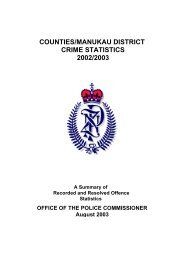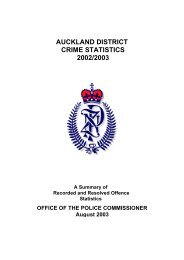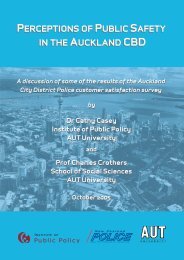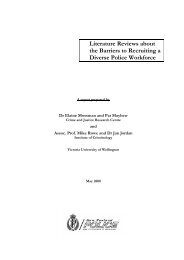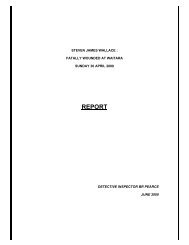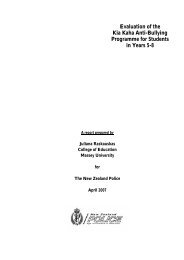Electronic Crime Strategy to 2010 - New Zealand Police
Electronic Crime Strategy to 2010 - New Zealand Police
Electronic Crime Strategy to 2010 - New Zealand Police
You also want an ePaper? Increase the reach of your titles
YUMPU automatically turns print PDFs into web optimized ePapers that Google loves.
Much e-crime is<br />
unsophisticated. It often involves<br />
activities on the Internet such as<br />
trading s<strong>to</strong>len property through<br />
auction sites, obtaining s<strong>to</strong>len<br />
credit card information from<br />
newsgroups and chat rooms,<br />
distributing pirated intellectual<br />
property, and dealing drugs<br />
through email and websites.<br />
The Internet has provided<br />
considerable opportunity for<br />
many offenders <strong>to</strong> extend<br />
their supply and cus<strong>to</strong>mer<br />
networks and exploit the reach<br />
of the medium – just as it has<br />
provided the same advantages<br />
<strong>to</strong> legitimate users. The use of<br />
technology for these criminal<br />
purposes causes challenges for<br />
<strong>Police</strong> because of sometimes<br />
demanding investigative<br />
requirements and apparent<br />
significant growth in some crime.<br />
<strong>Electronic</strong> <strong>Crime</strong><br />
Definition<br />
<strong>Police</strong> agencies worldwide have struggled <strong>to</strong> define their role in policing e-crime and<br />
<strong>to</strong> understand how <strong>to</strong> be effective in addressing the problem. This is partly because<br />
these types of crimes are extremely diverse. <strong>New</strong> <strong>Zealand</strong> <strong>Police</strong> consider electronic<br />
crime (e-crime) <strong>to</strong> cover:<br />
All offences where information and communications technology is:<br />
1. used as a <strong>to</strong>ol in the commission of an offence<br />
2. the target of an offence<br />
3. a s<strong>to</strong>rage device in the commission of an offence.<br />
E-crime includes traditional offending facilitated by technology such as telephony, the<br />
Internet and encryption. It also involves computer attacks. However, it is important <strong>to</strong><br />
recognise that the bulk of e-crime we currently see is not attributed <strong>to</strong> hackers.<br />
In <strong>New</strong> <strong>Zealand</strong>, e-crime mostly involves traditional offending with components<br />
having electronic means. This includes trading in illegal drugs, fraud, harassment,<br />
and many other types of criminal activity. Information technology has particularly<br />
influenced some traditional offending. Most notably, this includes:<br />
• fraud<br />
• identity theft<br />
• organised crime<br />
• paedophilia<br />
However, e-crime also includes new activity such as attacks on computers and new<br />
opportunities for crime enabled by electronic systems, such as services theft and<br />
software piracy. Worldwide these are significant and new problems.<br />
Nature of <strong>Electronic</strong> <strong>Crime</strong> Problem<br />
Criminals have exploited developments in information and communications<br />
technologies. It has provided them with new <strong>to</strong>ols and facilitated new criminal<br />
activity, which can now target computing infrastructure. Criminals can also exploit<br />
the fact that offending can easily cross jurisdictional boundaries and large distances.<br />
Increasing bandwidth, as well as supporting growth in commerce, is also increasing<br />
opportunities for criminals. Potential victims are becoming increasingly available<br />
as more people use these technologies. Many of these new users represent easy<br />
targets because they lack online security awareness or skills.<br />
Measuring e-crime problems affecting <strong>New</strong> <strong>Zealand</strong> is hampered by a lack of<br />
data for offences involving electronic components. The recent successful transfer<br />
of <strong>Police</strong> operational computer systems <strong>to</strong> NIA (the National Intelligence Application)<br />
and a <strong>Police</strong> <strong>Crime</strong> Statistics <strong>Strategy</strong> provide an opportunity <strong>to</strong> improve<br />
e-crime recording. This should allow for the capture of e-crime connections <strong>to</strong><br />
relevant offences.<br />
Local and Australian victimisation studies have collected some information about<br />
e-crime prevalence, though mainly about computer attacks. Most studies have not<br />
quantified growth in traditional crime facilitated by electronic means. However, <strong>Police</strong><br />
have moni<strong>to</strong>red the demand for forensic analysis of e-crime exhibits by the <strong>Electronic</strong><br />
<strong>Crime</strong> Labora<strong>to</strong>ry (ECL). The number of crimes involving electronic evidence has<br />
increased ten-fold over the past eight years. <strong>Electronic</strong> evidence is increasingly<br />
prominent in some types of offending such as fraud and sexual crime.<br />
Proportion of <strong>Electronic</strong> Exhibits Processed by ECL<br />
Sexual – Indecency 20%<br />
Fraud 18%<br />
Burglary & Theft 13%<br />
Homicide 8%<br />
Threats 4%<br />
Telecommunications Act 4%<br />
Aggravated robbery 3%<br />
Identity crime is one of the<br />
fastest growing types of crime in<br />
the world, and is defined as any<br />
offence involving the misuse of a<br />
personal identity. The majority of<br />
identity crime is committed with<br />
the help of computers.<br />
Identity crime often involves<br />
criminals obtaining information<br />
from everyday transactions like:<br />
• bank and credit card numbers<br />
• names<br />
• addresses<br />
• driver’s license details<br />
• log-on details for other<br />
services<br />
Criminals then use this<br />
information <strong>to</strong> commit fraud<br />
and theft. Opportunities in this<br />
area are increasing with the<br />
development of online auctions,<br />
gaming and other services.<br />
Computer users and businesses<br />
need <strong>to</strong> be vigilant <strong>to</strong> ensure that<br />
personal information is managed<br />
cautiously and with heightened<br />
security. This applies <strong>to</strong> the<br />
security of online transactions,<br />
paper waste containing<br />
sensitive information, personal<br />
details in wallets and purses<br />
and information on portable<br />
computers.<br />
Identity crime is a growing<br />
global problem – it knows<br />
no boundaries; victims and<br />
criminals can be on opposite<br />
sides of the world making it<br />
difficult for local law enforcement<br />
agencies <strong>to</strong> investigate the<br />
crime, catch the perpetra<strong>to</strong>r, or<br />
help the victim.<br />
Drugs 25%<br />
Receiving s<strong>to</strong>len goods 3%<br />
Assault 1%<br />
Kidnapping 1%<br />
Arson 1%<br />
2 E-CRIME STRATEGY TO <strong>2010</strong> E-CRIME STRATEGY TO <strong>2010</strong> 3



